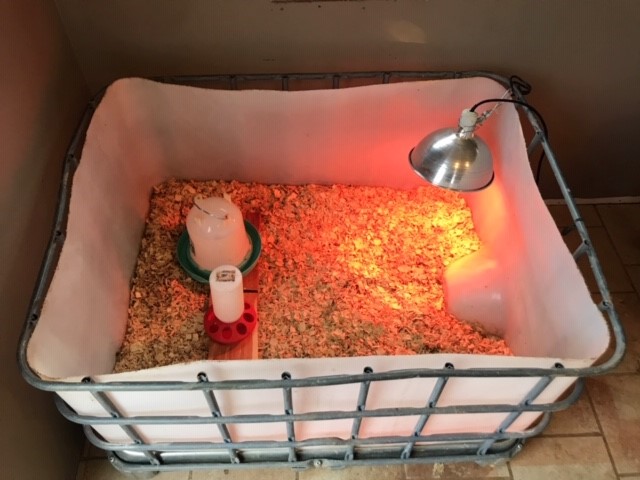The most important part of raising your own meat birds is preparation. We begin preparing well in advance, so when the baby chicks arrive, all that is left to do is put them happily in the brooder.
My husband is the mastermind of our setup and has built everything by hand. There may be considerable cost up front, but many things are a one time build and can be used again and again.
Before the chicks arrive, I already have the brooder ready. We use an old square shipping container with the top sawed off. It provides plenty of room for the growing chicks, and the plastic interior is easy to clean. I go ahead and fill it with pine shavings (beforehand I mix in about 1/4 cup of diatomaceous earth with the shavings. Be sure not to inhale. In my experience, this helps keep the chicks from getting coccidia. Coccidia is a type of worm found in chicken feces. It is serious and can kill an entire flock. If you notice a chick with bloody stool, it most likely has coccidia.) As well as being easy to clean, the plastic container is large enough that the babies can get out from under the lamp if they get too hot. I make sure the chick starter feed is bought, the feeders are ready, and the heat lamp works. One tip is to put a piece of thin wood under both the waterer and feeder, this keeps them from knocking shavings into their food/water. I do not recommend ever having baby chicks in your home as they will get very dirty quickly and can carry diseases over to your family. The best place to have your brooder is somewhere like a shed, garage, or workshop; somewhere with a power source and good ventilation.

Although the chicks will spend several weeks in the brooder, it is best to go ahead and have your chicken tractor made. A chicken tractor is essentially a simple coop with back wheels that can be moved to fresh grass daily. This is one of those expensive, but essential things you will need for meat chickens. Ours is a simple square with a wooden frame base. The top frame is made of plastic pipes, chicken wire, and a heavy duty tarp. It also has wheels on the back to make pulling easier. We put a 3 gallon waterer in a corner, sitting on a little wooden frame so it doesn’t drag when moved. For the feeder, we hang it up with a rope in the middle of the tractor. I am planning on putting a perch in this time around as well. The key is for the tractor to be light enough to pull and flush with the ground to keep predators from crawling under.
Now all that is left to do is pick up our 15 Rudd Rangers from the post office in about a week!
